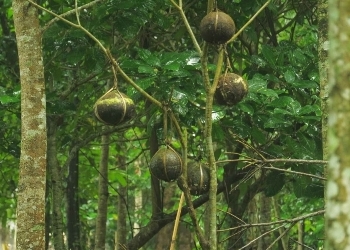You are here
Honoring The Placenta in Different Cultures

The placenta is a multifunctional organ that provides all the needs of the growing baby in the womb. After the baby is born, the placenta, or "the afterbirth," is not needed anymore. Different cultures handle its disposal differently. While some societies discard the placenta as biological waste, other cultures hold ceremonies to honor the placenta for its essential role in the baby's life.
In 2010, medical anthropologists Daniel Benyshek and Sharon Young studied the placenta traditions across 179 societies1. Among the 109 communities that held placenta rituals, there were 169 different disposal methods (!!), which included burial, incineration, placement in a specific location, or eating the placenta.
Many cultures believe that the placenta is a close relative to the child, and attribute human qualities to the placenta. Ancient Egyptians, as well as some other cultures, believed that the placenta is the child’s secret helper or guardian angel2. In Cambodia, the placenta is considered to be the origin of the baby's soul, and therefore the burial place is surrounded with spiked plants to protect the baby's soul from evil spirits3.
In many traditional communities, people believe that the condition of the placenta will predict the child's future skills and abilities. Also, it is believed that improper handling of the placenta can affect the health of the mother or the child. Thus, rituals for the handling of the placenta must be performed precisely and with great care. Many of these rituals involve washing the placenta in a special liquid, wrapping it within certain fabrics or plants, placing it in a specific vessel, and burying the placenta in an appropriate location.
Quite a few cultures believe that it is important to pick an auspicious place to bury the placenta. In Turkey, if parents wish their child to be devout, they bury the placenta in the courtyard of a mosque, whereas if they want their child to care for animals, they bury it in a stable4. In Malaysia, after the placenta is prepared with salt and tamarind, it is buried along with books and pencils under the doorway of the child’s house. The Malay believe that following this tradition will ensure the child will grow up to be hardworking and a good student5. But in Ukraine the beliefs were the opposite: the midwife must not bury the placenta in a doorway or any place where it would be stepped over, or else the mother would become infertile6.
 The Hmong people of South Asia believe that a person has a spiritual connection with his or her placenta throughout life. It is important for the placenta to be buried at home. When a Hmong person dies, the soul returns to its birthplace and reunites with its placenta, which helps the deceased travel into the spirit world to join ancestors7.
The Hmong people of South Asia believe that a person has a spiritual connection with his or her placenta throughout life. It is important for the placenta to be buried at home. When a Hmong person dies, the soul returns to its birthplace and reunites with its placenta, which helps the deceased travel into the spirit world to join ancestors7.
The Maori people of New Zealand use the same word for placenta and land: “Whenua”. They believe that the placenta burial symbolizes the connection between the newborn baby and mother earth8-10.
On the Indonesian island of Bali, the native tradition is to enclose the placenta in a coconut shell and hang it from a tree in the village graveyard. It is believed this will protect the child from illness and misfortune. The village of Bayung Gede has become a tourist attraction due to the hundreds of placentas hanging in its graveyard. Indonesia’s Ministry of Education and Culture declared the cemetery a national heritage site in Oct. 202011.
While some of these rituals may seem superstitious, the respect shown the placenta since ancient times indicates that our ancestors knew there is more to the placenta than just medical waste.
References
- Young SM, and Benyshek DC. In search of human placentophagy: a cross-cultural survey of human placenta consumption, disposal practices, and cultural beliefs. Ecol Food Nutr. 2010; 49(6):467-84.
- Ober WB. Notes on placentophagy. Bull N Y Acad Med. 1979; 55(6): 591–599.
- Wikipedia. Placenta. Last updated 20201223
- Republic of Turkey Ministry of Culture and Tourism. Birth Traditions. Accessed Dec.2020
- Official Website Of The National Department For Culture And Arts, Ministry of Tourism Malaysia, Malay Community. Accessed Dec.2020
- Boryak O. The midwife in traditional Ukrainian culture. Ritual, folklore and mythology. Midwifery Today Int Midwife 2003; (65):52-4.
- Helsel DG, and Mochel M. Afterbirths in the Afterlife: Cultural Meaning of Placental Disposal in a Hmong American Community. J Transcultural Nursing 2002; 13(4):282-6.
- Durie HM. A Maori perspective of health. Social Science & Medicine 1985; 20(5):483-486.
- Aotearoa HB. Whenua to whenua. Home Birth Matters Published Sep.2014
- Emma Jean Photography Facebook Published 20160102
- Daniels JM. Hanging Placenta Trees of Bayung Gede, Bali. Bali Discovery. Last updated 20201019

 Liat Ben-Senior holds an MBA and MSc in Human Genetics from the Sackler School of Medicine of Tel-Aviv University, Israel. She has over 15 years experience in Marketing and Digital Marketing in the field of Biotech and Life Sciences. Her scientific background includes immunology and molecular biology research, both in academia as well as industry. Her management background includes business development and commercialization of early stage medical devices, cellular, and small molecule therapies. For over a decade, Liat worked with CReATe Cord Blood Bank as Business Manager. At CReATe, Liat focused on educating expectant parents and health care professionals about the cord blood banking options available in the Canadian market. Starting in 2020, Liat is the Marketing Manager at
Liat Ben-Senior holds an MBA and MSc in Human Genetics from the Sackler School of Medicine of Tel-Aviv University, Israel. She has over 15 years experience in Marketing and Digital Marketing in the field of Biotech and Life Sciences. Her scientific background includes immunology and molecular biology research, both in academia as well as industry. Her management background includes business development and commercialization of early stage medical devices, cellular, and small molecule therapies. For over a decade, Liat worked with CReATe Cord Blood Bank as Business Manager. At CReATe, Liat focused on educating expectant parents and health care professionals about the cord blood banking options available in the Canadian market. Starting in 2020, Liat is the Marketing Manager at